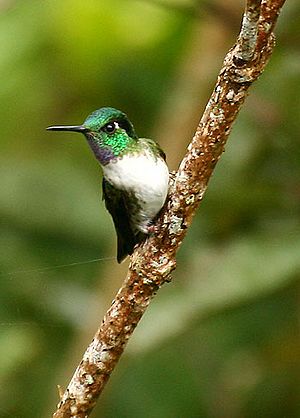White-bellied mountaingem facts for kids
Quick facts for kids White-bellied mountaingem |
|
|---|---|
 |
|
| Conservation status | |
| Scientific classification | |
| Genus: |
Lampornis
|
| Species: |
hemileucus
|
The white-bellied mountaingem is a beautiful type of hummingbird. You might also hear it called the white-bellied mountain-gem. Its scientific name is Lampornis hemileucus. This tiny bird lives in the warm, green forests of Costa Rica and Panama.
About the White-bellied Mountaingem
Bird Families and Names
Scientists group living things into families. This helps us understand how they are related. The white-bellied mountaingem belongs to the hummingbird family.
It is currently placed in the Lampornis group. However, some scientists think it might fit better in a different group. This is because new information sometimes changes how we understand bird families.
What Does the White-bellied Mountaingem Look Like?
The white-bellied mountaingem is a small bird. It is about 10 to 11 centimeters (4 to 4.3 inches) long. Males are a bit heavier, weighing about 6.2 grams (0.22 ounces). Females weigh around 5.1 grams (0.18 ounces).
Both male and female birds have a black beak that is not too long. They also have a clear white stripe behind each eye. Their feet are a pretty pink color.
Male and Female Differences
Adult male white-bellied mountaingems have a sparkling green face and head. Most of their upper body is a shiny bronze-green. The feathers covering their tail are also bronze. Their tail is bronze too, with dark gray bands near the ends of the outer feathers.
The male's throat has a bright blue-violet patch called a gorget. The rest of their belly is white, with green spots along the sides.
Adult females look similar to males. But their face and head are not as sparkly. Their throat is white with green spots, instead of the blue-violet gorget. Young birds of both sexes have rusty edges on their green feathers. Young males have a dull bronze gorget.
Where the White-bellied Mountaingem Lives
The white-bellied mountaingem lives in Costa Rica and Panama. You can find it on the Caribbean side of Costa Rica, going south and east into western Panama. It lives as far as Veraguas Province in Panama. Sometimes, it is also found on the Pacific side of Panama.
This hummingbird likes to live in the tops of cool, very wet forests. These are called subtropical forests. It also likes to be in the bushes at the edge of the forest. You might see it in open spaces or clearings within the forest. It usually avoids forests that have been cut down and are growing back. It also does not like other open areas.
How the White-bellied Mountaingem Moves
In Costa Rica, these hummingbirds move to different places during the year. They usually lay their eggs and raise their young at higher elevations. This is between 700 and 1400 meters (2,300 to 4,600 feet) high. After their young are grown, they fly down to lower areas. They go to elevations between 400 and 600 meters (1,300 to 2,000 feet).
What the White-bellied Mountaingem Eats
The white-bellied mountaingem eats nectar from flowers. It finds nectar in flowering trees and bushes. It especially likes plants that grow on other plants, called epiphytes. These include plants from the Ericaceae family and the Columnea group.
These hummingbirds can be quite strong when they are eating. Male white-bellied mountaingems often chase away other hummingbirds from good flower patches. They do this even to birds that are bigger than them! Besides nectar, they also catch insects while flying. Females sometimes pick small bugs off leaves.
Reproduction and Life Cycle
The white-bellied mountaingem lays its eggs and raises its young between August and March in Costa Rica. We do not have many details about their nests. Scientists also do not know much about how their breeding cycle works.
Sounds and Calls
The song of the white-bellied mountaingem is a mix of different sounds. It includes squeaks, dry or wet trills, and sputtering notes. When it is chasing another bird, it makes "squeaky sputtering trills." Other calls include a repeated, somewhat nasal "deep" sound. It also makes rattling sounds like "de-de-drrrrr."
Conservation Status
The IUCN (International Union for Conservation of Nature) has looked at the white-bellied mountaingem. They have listed it as a species of "Least Concern." This means it is not in immediate danger of disappearing.
However, it lives in a somewhat small area. We do not know exactly how many of these birds there are. We also do not know if their numbers are going up or down. Even so, it is common in many places. A lot of its natural home is still safe. This is especially true in three national parks in Costa Rica.
See also
 In Spanish: Colibrí gorgivioleta para niños
In Spanish: Colibrí gorgivioleta para niños


